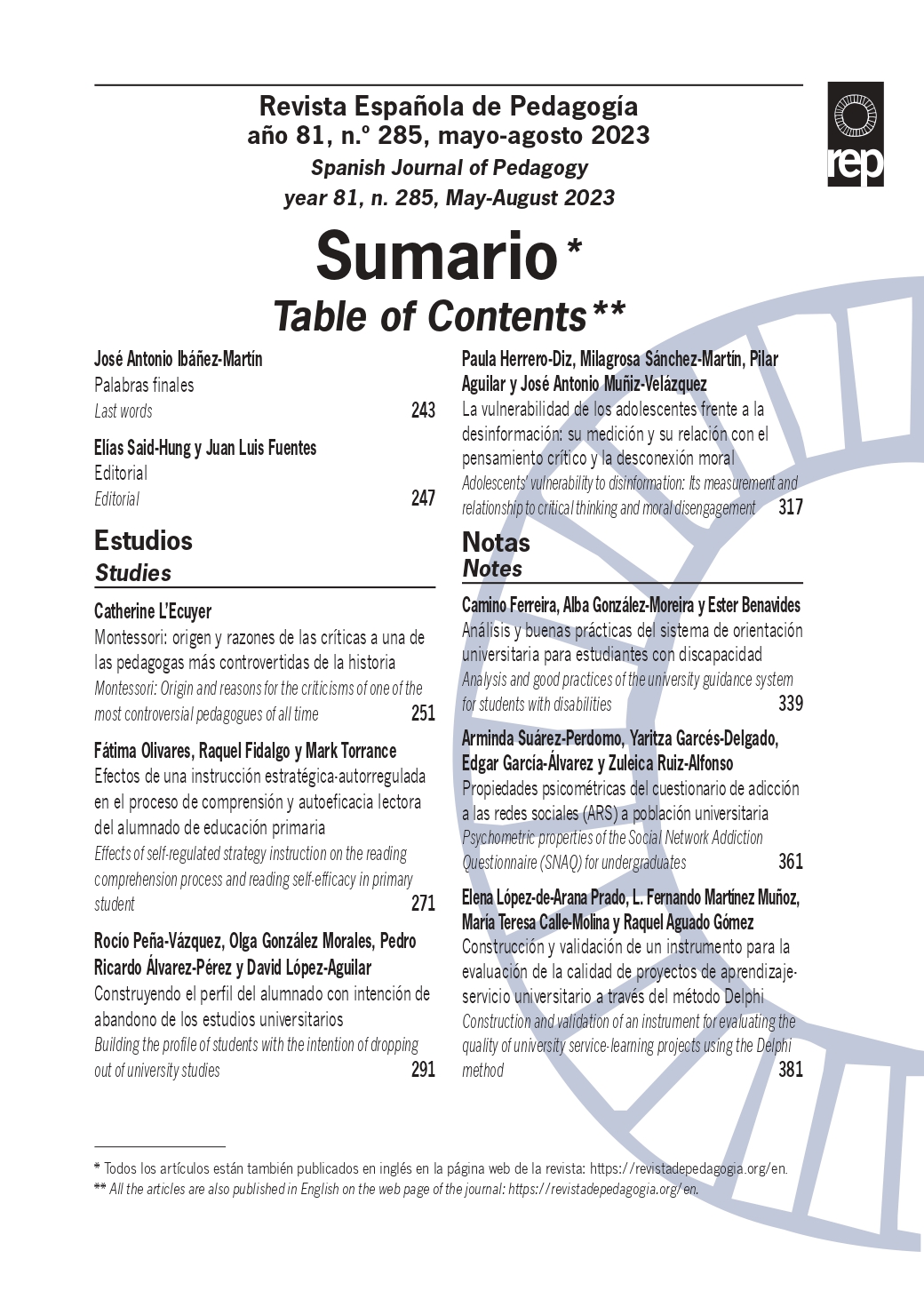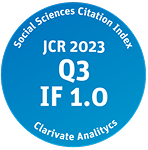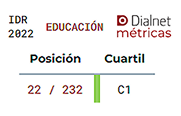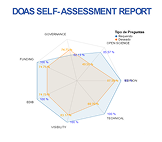Adolescents' vulnerability to disinformation: Its measurement and relationship to critical thinking and moral disengagement.
DOI:
https://doi.org/10.22550/REP81-2-2023-04Keywords:
disinformation, young people, teenagers, scale, critical thinking, media literacy, moral disengagementAbstract
Young adolescents are more vulnerable to disinformation owing to the time that they spend online and their content consumption habits. The consequences of this phenomenon can be serious, both for the individual and at a social and political level. To alleviate this situation, different agencies recommend healthy practices regarding consumption and exchange of information; from checklists to self-learning exercises for the development of critical thinking. This research proposes a tool for the identification of behaviours among adolescents when giving credibility to information or content and the motives that lead them to share it, contributing at times to the spread of misleading information. After an exhaustive process of design, piloting, and psychometric validation using an English-speaking sample (N = 417), a reliable instrument was obtained. We also measured its correlation with critical thinking and moral disengagement. The results lead us to conclude that this is a new tool with which to observe the information consumption behaviours of young people and thus measure their vulnerability to disinformation. Similarly, we have confirmed how greater critical thinking is positively related to more responsible consumption when giving credibility to content or news, and how moral disengagement is linked to the fact of sharing such items with greater ease.
Downloads
References
Ackland, R., y Gwynn, K. (2020). Truth and the dynamics of news diffusion on Twitter [La verdad y la dinámica de difusión de noticias en Twitter]. En R. Greifeneder, M. E. Jaffé, E. J. Newman y N. Schwarz (Ed.), The psychology of fake news (pp. 27-46). Routledge.
Agencia Española de Protección de Datos. (2020). Guía de protección de datos por defecto. https://www.aepd.es/es/node/45107
Bandura, A. (2002). Selective moral disengagement in the exercise of moral agency [Desvinculación moral selectiva en el ejercicio de la agencia moral]. Journal of Moral Education, 31 (2), 101-119. https://doi.org/10.1080/0305724022014322
Bandura, A., Barbaranelli, C., Caprara, G. V., y Pastorelli, C. (1996). Mechanisms of moral disengagement in the exercise of moral agency [Mecanismos de desvinculación moral en el ejercicio de la agencia moral]. Journal of Personality and Social Psychology, 71 (2), 364-374. https://doi.org/10.1037/0022-3514.71.2.364
Blakeslee, S. (2004). The CRAAP test [La prueba CRAAP]. LOEX Quarterly, 31 (3), 4.
Caulfield, M. (2017). Web literacy for student fact-checkers [Alfabetización web para estudiantes verificadores de datos]. Textbooks. 5. https://digitalcommons.liberty.edu/textbooks/5
Corbu, N., Oprea, D. A., y Frunzaru, V. (2021). Romanian adolescents, fake news, and the third-person effect: A cross-sectional study [Adolescentes rumanos, fake news y el efecto de tercera persona: un estudio transversal]. Journal of Children and Media, 1-19. https://doi.org/10.1080/17482798.2021.1992460
DeVellis, R. F. (2017). Scale development: Theory and applications [Desarrollo de escalas: teoría y aplicaciones]. Sage.
Dring, S. (2020). Fact vs fiction: Teaching critical thinking skills in the age of fake news [Realidad frente a ficción: enseñar a pensar críticamente en la era de las noticias falsas]. The School Librarian, 68 (1), 63-63.
Dumitru, E. A. (2020). Testing children and adolescents’ ability to identify fake news: A combined design of quasi-experiment and group discussions [Comprobación de la capacidad de niños y adolescentes para identificar noticias falsas: un diseño combinado de cuasi-experimento y debates en grupo]. Societies, 10 (3), 71. https://doi.org/10.3390/soc10030071
Dunn, T. J., Baguley, T., y Brunsden, V. (2013). From alpha to omega: A practical solution to the pervasive problem of internal consistency estimation [De alfa a omega: una solución práctica al omnipresente problema de la estimación de la consistencia interna]. British Journal of Psychology, 105 (3), 295-441. https://doi.org/10.1111/bjop.12046
Elosúa, P. (2003). Sobre la validez de los tests. Psicothema, 15 (2), 315-321. https://www.psicothema.com/pi?pii=1063
Ferrando, P. J. y Lorenzo-Seva, U. (2014). El análisis factorial exploratorio de los ítems: algunas consideraciones adicionales. Anales de Psicología, 30 (3), 1170-1175. https://dx.doi.org/10.6018/analesps.30.3.199991
Ferrando, P. J., Lorenzo-Seva, U., y Navarro-González, D. (2019). Unival: An FA-based R package for assessing essential unidimensionality using external validity information [Unival: un paquete R basado en FA para evaluar la unidimensionalidad esencial utilizando información de validez externa]. The R Journal, 11 (1), 427- 436. https://doi.org/10.32614/rj-2019-040
Fleiss, J. L., Levin, B., y Paik, M. C. (2003). Statistical methods for rates and proportions [Métodos estadísticos para tasas y proporciones]. Wiley.
Fornell, C., y Larcker, D. F. (1981). Evaluating structural equation models with unobservable variables and measurement error [Evaluación de modelos de ecuaciones estructurales con variables inobservables y errores de medición]. Journal of Marketing Research, 18 (1), 39-50.
Greifeneder, R., Jaffe, M., Newman, E., y Schwarz, N. (2021). The psychology of fake news: Accepting, sharing, and correcting misinformation [La psicología de las noticias falsas: aceptar, compartir y corregir la desinformación]. Routledge.
Grizzle, A., Wilson, C., Tuazon, R., Cheung, C. K., Lau, J., Fischer, R., Gordon, D., Akyempong, K., Singh, J., Carr, P. R., Stewart, K., Tayie, S., S., Jaakkola, M., Thésée, G., Gulston, C., Andzongo M., Blaise P., Zibi F., y Paul A. (2021). Media and information literate citizens: think critically, click wisely! [Ciudadanos alfabetizados en medios de comunicación e información: ¡piensa críticamente, haz clic sabiamente!] UNESCO. https://unesdoc.unesco.org/ark:/48223/pf0000377068
Gómez-Calderón, B., Córdoba-Cabús, A., y Nieto, A. M. (2020). Jóvenes y fake news. Un análisis sociodemográfico aplicado al caso andaluz. IC Revista Científica de Información y Comunicación, 17, 481-504. http://dx.doi.org/10.12795/IC.2020.i01.21
Guan, T., Liu, T., y Yuan, R. (2021). Facing disinformation: Five methods to counter conspiracy theories amid the Covid-19 pandemic [Combatiendo la desinformación: cinco métodos para contrarrestar las teorías de conspiración en la pandemia de Covid-19]. Comunicar, 69, 71-83. https://doi.org/10.3916/C69-2021-06
Gwet, K. L. (2014). Handbook of inter-rater reliability [Manual de fiabilidad entre evaluadores]. Advanced Analytics.
Halstead, J. M. (2010). Moral education [Educación moral]. En C. S. Clauss-Ehlers (Eds), Encyclopedia of cross-cultural school psychology. Springer. https://doi.org/10.1007/978-0-387-71799-9_260
Hancock, G. R., y Mueller, R. O. (2001). Rethinking construct reliability within latent variable systems [Replanteamiento de la fiabilidad de los constructos en los sistemas de variables latentes]. En R. Cudeck, S. du Toit y D. Srbom (Eds.), Structural equation modeling: Present and future-a festschrift in honor of Karl Joreskog (pp. 195-216). Scientific Software International.
Harkness, J., y Schoua-Glusberg, A. (1998). Questionnaires in translation [Cuestionarios en traducción]. En J. Harkness (Ed.), Cross-cultural survey equivalence (pp. 87-126). Zentrum für Umfragen, Methoden und Analysen -ZUMA-.
Harris, R. (1997). Evaluating Internet research sources [Evaluación de las fuentes de investigación en Internet]. Virtual Salt, 17 (1), 1-17.
Head, A., y Wihbey, J. (9 abril 2017). The importance of truth workers in an era of factual recession [La importancia de los trabajadores de la verdad en una época de recesión fáctica]. Medium. https://medium.com/@ajhead1/the-importance-of-truth-workersin-an-era-of-factual-recession-7487fda8eb3b
Herrero-Diz, P., Conde-Jiménez, J., y Reyes de Cózar, S. (2020). Teens’ motivations to spread fake news on WhatsApp [Las motivaciones de los adolescentes para difundir noticias falsas en WhatsApp]. Social Media + Society, 6 (3). https://doi.org/10.1177/2056305120942879
Herrero-Diz, P., Conde-Jiménez, J., y Reyes-de-Cózar, S. (2021). Spanish adolescents and fake news: Level of awareness and credibility of information [Los adolescentes españoles frente a las fake news: nivel de conciencia y credibilidad de la información]. Culture and Education, 33 (1), 1-27. https://doi.org/10.1080/11356405.2020.1859739
Hooper, D., Coughlan, J., y Mullen, M. R. (2008). Structural equation modelling: Guidelines for determining model fit. Electronic Journal of Business Research Methods, 6 (1), 53-60. https://doi.org/10.21427/D7CF7R
Jones-Jang, S. M., Mortensen, T., y Liu, J. (2021). Does media literacy help identification of fake news? Information Literacy helps, but other literacies don’t [¿Ayuda la alfabetización mediática a identificar las noticias falsas? La alfabetización informacional ayuda, pero otras alfabetizaciones no]. American Behavioral Scientist, 65 (2), 371- 388. https://doi.org/10.1177/0002764219869406
Kaiser, H. F (1970). A second-generation little jiffy [Un pequeño jiffy de segunda generación]. Psychometrika, 35, 401-415. https://doi.org/10.1007/BF02291817
Landis, J. R., y Koch, G. G. (1977). The measurement of observer agreement for categorical data [Medición de la concordancia de los observadores en datos categóricos]. Biometrics, 33, 159-174.
Lawshe, C. H. (1975). A quantitative approach to content validity [Un enfoque cuantitativo de la validez de contenido]. Personnel psychology, 28 (4), 563-575. https://doi.org/10.1111/j.1744-6570.1975.tb01393.x
Ley Orgánica 3/2018, de 5 de diciembre, de Protección de Datos Personales y garantía de los derechos digitales. Boletín Oficial del Estado, 294, de 6 de diciembre de 2018, páginas 119788 a 119857. https://www.boe.es/eli/es/lo/2018/12/05/3
Lorenzo-Seva, U. (1999). Promin: A method for oblique factor rotation [Promin: un método de rotación factorial oblicua]. Multivariate Behavioral Research, 34, 347-365.
Lorenzo-Seva, U., y Ten Berge, J. M. (2006). Tucker’s congruence coefficient as a meaningful index of factor similarity [El coeficiente de congruencia de Tucker como índice significativo de similitud factorial]. Methodology, 2, 57-64. https://doi.org/10.1027/1614-2241.2.2.57
Lynn, M. R. (1986). Determination and quantification of content validity [Determinación y cuantificación de la validez del contenido]. Nursing Research, 35, 382-385.
Mandalios, J. (2013). RADAR: An approach for helping students evaluate Internet sources. Journal of Information Science, 39, 470-478. https://doi.org/10.1177/0165551513478889
McGrew, S. (2020). Learning to evaluate: An intervention in civic online reasoning [Aprender a evaluar: una intervención en el razonamiento cívico en línea]. Computers & Education, 145, 103711. https://doi.org/10.1016/j.compedu.2019.103711
McKay, S., y Tenove, C. (2021). Disinformation as a threat to deliberative democracy [La desinformación como amenaza para la democracia deliberativa]. Political Research Quarterly, 74 (3), 703- 717. https://doi.org/10.1177/1065912920938143
Newman, E. J., y Zhang, L. (2020). Truthiness: How non-probative photos shape belief [Veracidad: cómo las fotos no probatorias moldean la creencia]. En R. Greifeneder, M. E. Jaffé, E. J. Newman y N. Schwarz (Ed.), The psychology of fake news (pp. 90-114). Routledge.
Nieto-Isidro, S., Martínez-Abad, F., y Rodríguez-Conde, M.-J. (2021). Presente y futuro de la Competencia Informacional Docente en educación oobligatoria [Present and future of Teachers' Information Literacy in compulsory educatio]. Revista Española de Pedagogía, 79 (280), 477- 496. https://doi.org/10.22550/REP79-3-2021-07
Ofcom. (Ed.) (2019). Children and parents: Media use and attitudes report, 2018 [Niños y padres: informe sobre el uso de los medios de comunicación y las actitudes, 2018]. https://www.ofcom.org.uk/research-and-data/media-literacyresearch/childrens/children-and-parentsmedia-use-and-attitudes-report-2018
Osborne, J., Costello, A., y Kellow, J. (Eds.) (2008). Best practices in exploratory factor analysis. SAGE Publications, Inc. https://doi.org/10.4135/9781412995627
Park, N., y Peterson, C. (2006). Moral competence and character strengths among adolescents: The development and validation of the Values in Action Inventory of Strengths for Youth [Competencia moral y fortalezas del carácter entre los adolescentes: el desarrollo y la validación del Inventario de Fortalezas de Valores en Acción para Jóvenes.]. Journal of Adolescence, 29 (6), 891-909. https://doi.org/10.1016/j.adolescence.2006.04.011
Paul, R., y Scriven, M. (2003). Defining critical thinking. The Foundation for Critical Thinking. http://www.criticalthinking.org/pages/definingcritical-thinking/766
Pérez-Escoda, A., Pedrero-Esteban, L. M., Rubio-Romero, J., y Jiménez-Narros, C. (2021). Fake news reaching young people on social networks: Distrust challenging media literacy [Las noticias falsas llegan a los jóvenes en las redes sociales: la desconfianza como reto a la alfabetización mediática]. Publications, 9 (2), 24. https://doi.org/10.3390/publications9020024
Pithers, R. T., y Soden, R. (2000). Critical thinking in education: A review [El pensamiento crítico en la educación: una revisión]. Educational research, 42 (3), 237-249.
Plan Internacional (Ed.) (2021). The truth gap (des) informadas online. Cómo la desinformación y la información errónea online afectan a la vida, el aprendizaje y el liderazgo de las niñas, adolescentes y mujeres jóvenes. https://bit.ly/3D7UmTY
Rodríguez, A., Reise, S. P., y Haviland, M. G. (2016). Applying bifactor statistical indices in the evaluation of psychological measures [Aplicación de índices estadísticos bifactoriales en la evaluación de medidas psicológicas]. Journal of Personality Assessment, 98, 223-237. https://doi.org/10.1080/00223891.2015.1089249
Sireci, S., y Faulkner-Bond, M. (2014). Validity evidence based on test content [Pruebas de validez basadas en el contenido de las pruebas]. Psicothema, 26 (1), 100-107.
Tamboer, S. L., Kleemans, M., y Daalmans, S. (2020). ‘We are a neeeew generation’: Early adolescents’ views on news and news literacy [«Somos una nueva generación»: la opinión de los adolescentes sobre las noticias y la alfabetización informative]. Journalism. https://doi.org/10.1177/1464884920924527
Timmerman, M. E., y Lorenzo-Seva, U. (2011). Dimensionality assessment of ordered polytomous items with parallel analysis. Psychological Methods, 16 (2), 209-220.
Downloads
Published
-
Abstract447
-
PDF (Español)189
-
PDF96
How to Cite
Issue
Section
License

This work is licensed under a Creative Commons Attribution-NonCommercial 4.0 International License.

